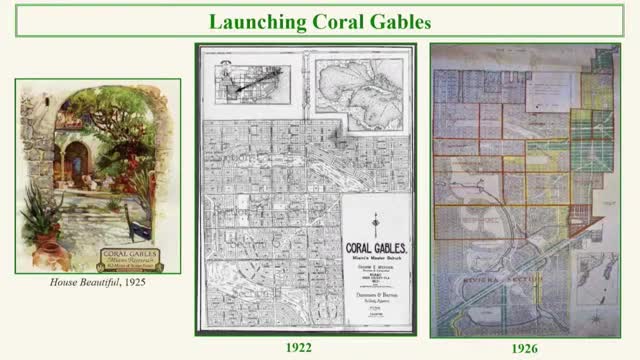George Merrick's ambitious vision transforms Coral Gables
August 22, 2024 | Coral Gables, Miami-Dade County, Florida
This article was created by AI summarizing key points discussed. AI makes mistakes, so for full details and context, please refer to the video of the full meeting. Please report any errors so we can fix them. Report an error »

Coral Gables, a pioneering planned community in South Florida, was founded by George Merrick during the real estate boom of the 1920s. Drawing inspiration from the Garden City and City Beautiful movements, Merrick envisioned a Mediterranean-style city that would become a model for modern urban planning in the United States.
In the early 1920s, Merrick's ambitious plans began to take shape, aided by nationally acclaimed landscape architect Frank Button, who created the first comprehensive maps of the area. By March 1925, Merrick had acquired 6,000 acres along Biscayne Bayou, which he envisioned as the Riviera section, intended to house the University of Miami, an extensive waterway system, and various recreational amenities.
As demand for housing surged, Merrick implemented a multi-faceted strategy to address the housing shortage. This included the establishment of temporary housing solutions, such as a tent city, and the commissioning of the San Sebastian apartments. He also sought partnerships with investors to expedite construction efforts.
A significant milestone occurred on August 2, 1925, when Merrick announced a $75 million contract with financier Myers Cooper to expand Coral Gables' architectural offerings. This collaboration led to the formation of the American Building Corporation, which aimed to introduce a diverse range of architectural styles, including Italian, Moorish, and French influences, while maintaining the city’s Mediterranean roots.
Despite the ambitious plans for the Riviera section, including the development of distinct village-type groupings, the project faced challenges and was never fully realized. However, several areas were initiated, with seven now recognized as historic districts. The vision for the Riviera section was to create a unique atmosphere, distinct from other parts of Coral Gables, showcasing a variety of architectural styles, particularly Italian-inspired homes.
The first homes under the American Building Corporation project were designed by architect Frank Wyatt Woods, blending Mediterranean Revival styles with Italian country house features. This architectural evolution reflects Merrick's enduring legacy in shaping Coral Gables into a vibrant and historically rich community.
In the early 1920s, Merrick's ambitious plans began to take shape, aided by nationally acclaimed landscape architect Frank Button, who created the first comprehensive maps of the area. By March 1925, Merrick had acquired 6,000 acres along Biscayne Bayou, which he envisioned as the Riviera section, intended to house the University of Miami, an extensive waterway system, and various recreational amenities.
As demand for housing surged, Merrick implemented a multi-faceted strategy to address the housing shortage. This included the establishment of temporary housing solutions, such as a tent city, and the commissioning of the San Sebastian apartments. He also sought partnerships with investors to expedite construction efforts.
A significant milestone occurred on August 2, 1925, when Merrick announced a $75 million contract with financier Myers Cooper to expand Coral Gables' architectural offerings. This collaboration led to the formation of the American Building Corporation, which aimed to introduce a diverse range of architectural styles, including Italian, Moorish, and French influences, while maintaining the city’s Mediterranean roots.
Despite the ambitious plans for the Riviera section, including the development of distinct village-type groupings, the project faced challenges and was never fully realized. However, several areas were initiated, with seven now recognized as historic districts. The vision for the Riviera section was to create a unique atmosphere, distinct from other parts of Coral Gables, showcasing a variety of architectural styles, particularly Italian-inspired homes.
The first homes under the American Building Corporation project were designed by architect Frank Wyatt Woods, blending Mediterranean Revival styles with Italian country house features. This architectural evolution reflects Merrick's enduring legacy in shaping Coral Gables into a vibrant and historically rich community.
View full meeting
This article is based on a recent meeting—watch the full video and explore the complete transcript for deeper insights into the discussion.
View full meeting